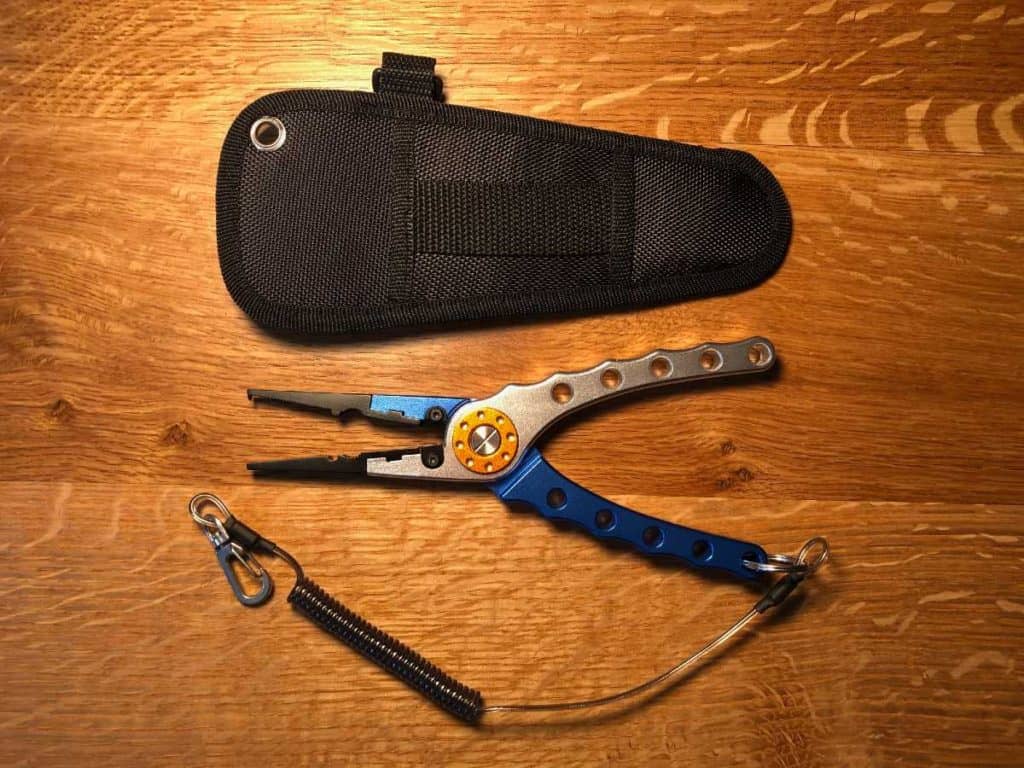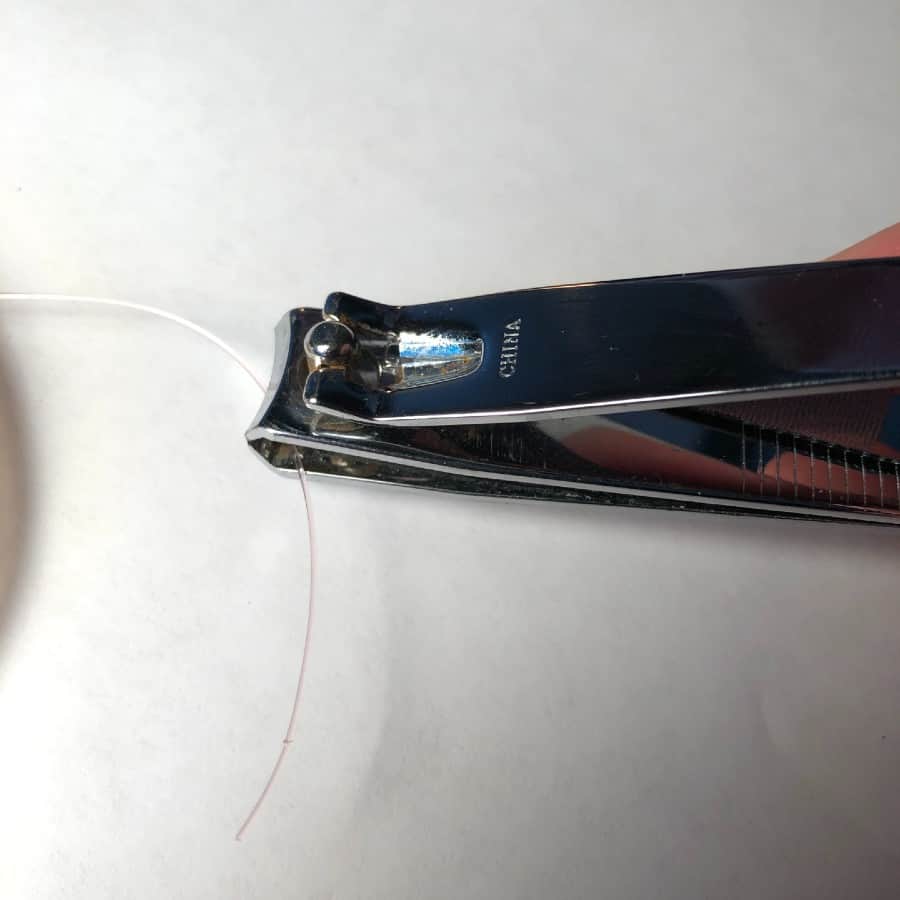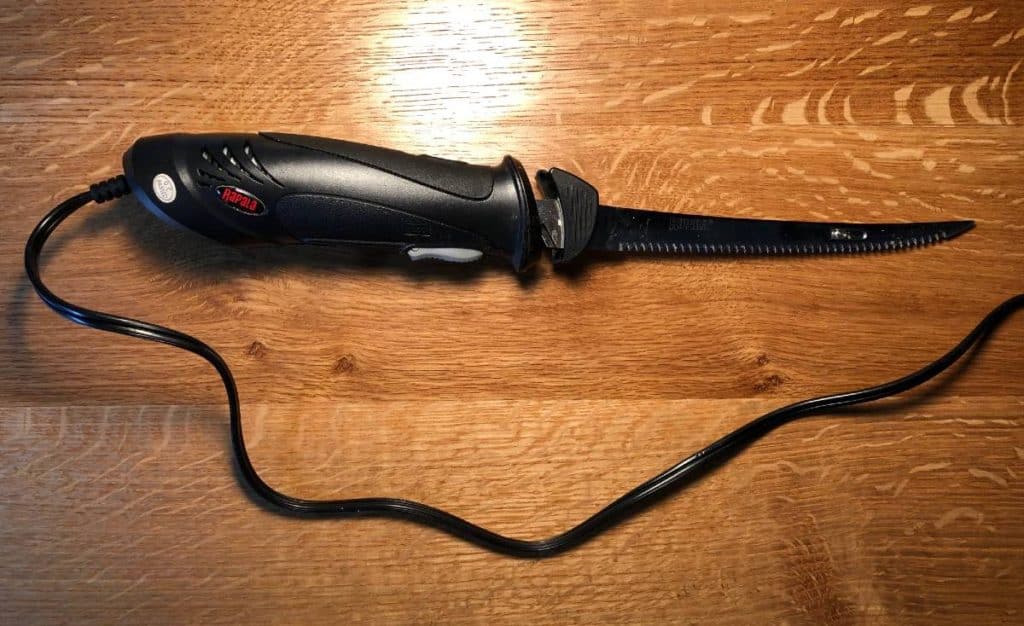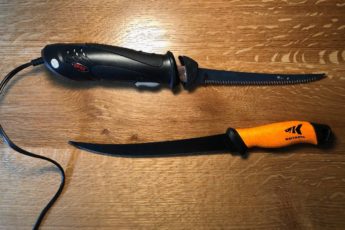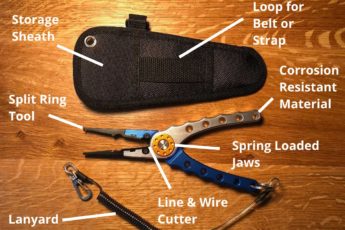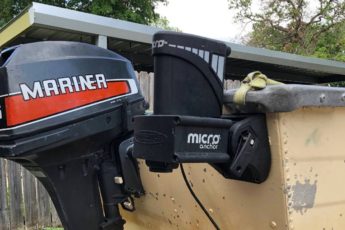This article will help you stock your tackle box with true essentials to get you out catching more fish. Most marketed fishing gear is designed to catch customers (you) first and catch fish second.
Shop less, fish more! This article will help you focus on what gear you actually need for successful fishing trips.
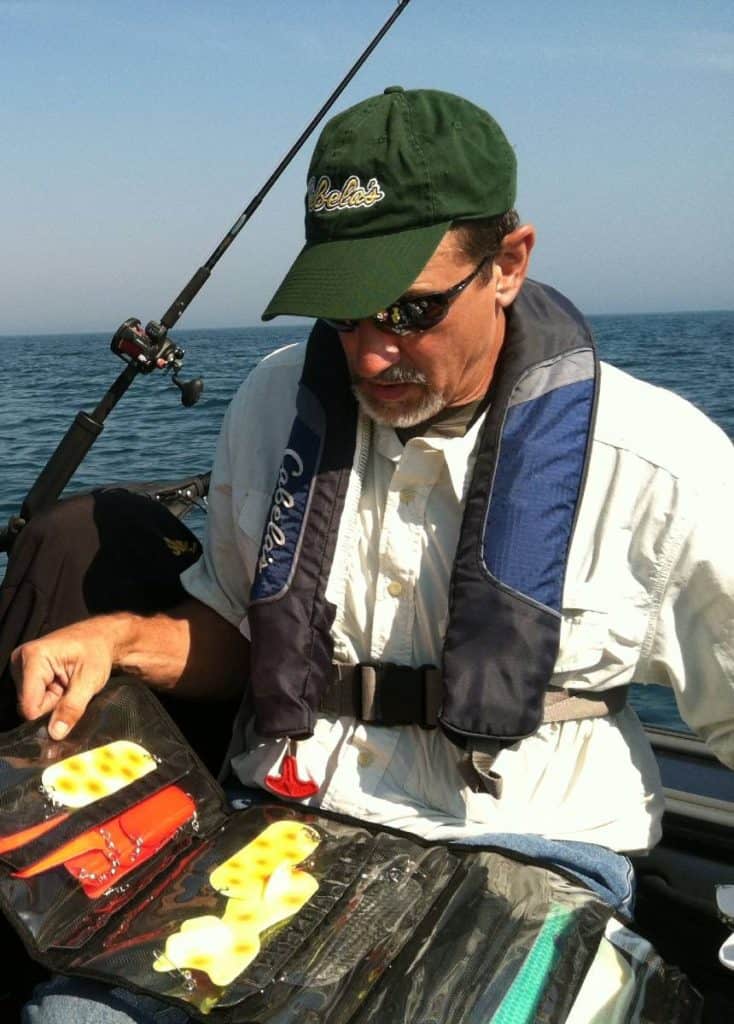
This information is targeted for new anglers primarily fishing from shore or a small boat.
*Disclosure: I only recommend products I would use myself and all opinions expressed here are my own. This post may contain affiliate links that at no additional cost to you, I may earn a small commission.
Essential Gear for Every Tackle Box
Every tackle box needs a few key components.
Essential:
- Pliers
- Ruler
- Cutting Tool
- Physical bag or box to carry your gear
- Assorted Hooks
- Assorted Sinkers
- Fillet Knife
- Tackle specific to the target species (see the below sections for more details)
Recommended:
- Sunscreen
- Bug Spray
- Towel
- Fishing Net
Why Should Every Tackle Box Have These Items?
I have found most how-to fishing articles will tell you the ‘what’ but frequently do not tell you the ‘why’.
You may notice a lack of specific baits on the essential list. This is because on every fishable body of water, you can catch something with live bait on a hook & sinker. Specific baits like spinnerbaits or bass frogs can be deadly effective, but may be too specialized when kitting out your tackle box basics.
Grab the essentials then specialize from there. See my below recommendations based on years of fishing experience.
Fishing Pliers
The first key component of a fishing tackle box is fishing pliers.
The most critical use-case for fishing pliers is removing tricky hooks from fish. If a fish is gut-hook you need pliers to reach and remove the hook without significantly harming the fish. Pliers also keep your hands away from sharp fish teeth! Check out our detailed breakdown for fishing pliers.
When picking fishing pliers make sure they are skinny enough to fit far inside the mouth of your target fish species. I am partial to a hemostat forcep style pliers because you can ‘lock’ it while you attempt to unhook the fish. Needle nose style pliers are also a popular option.
Cheap pliers will get the job done but will likely rust quickly and have limited (zero) additional features. Higher quality pliers make for good fishing gifts, are made of better materials, and have additional features like a lanyard or line cutter.
Ruler
The second key component of a fishing tackle box is a basic ruler! A ruler is necessary to check if fish are legal keeper size (and for bragging rights). There are many options for rulers:
- Dedicated fishing ruler
- Adhesive fishing ruler for your favorite fishing rod
- Fishing coolers commonly have built in rulers
Any accurate ruler will do. No need to overcomplicate it!
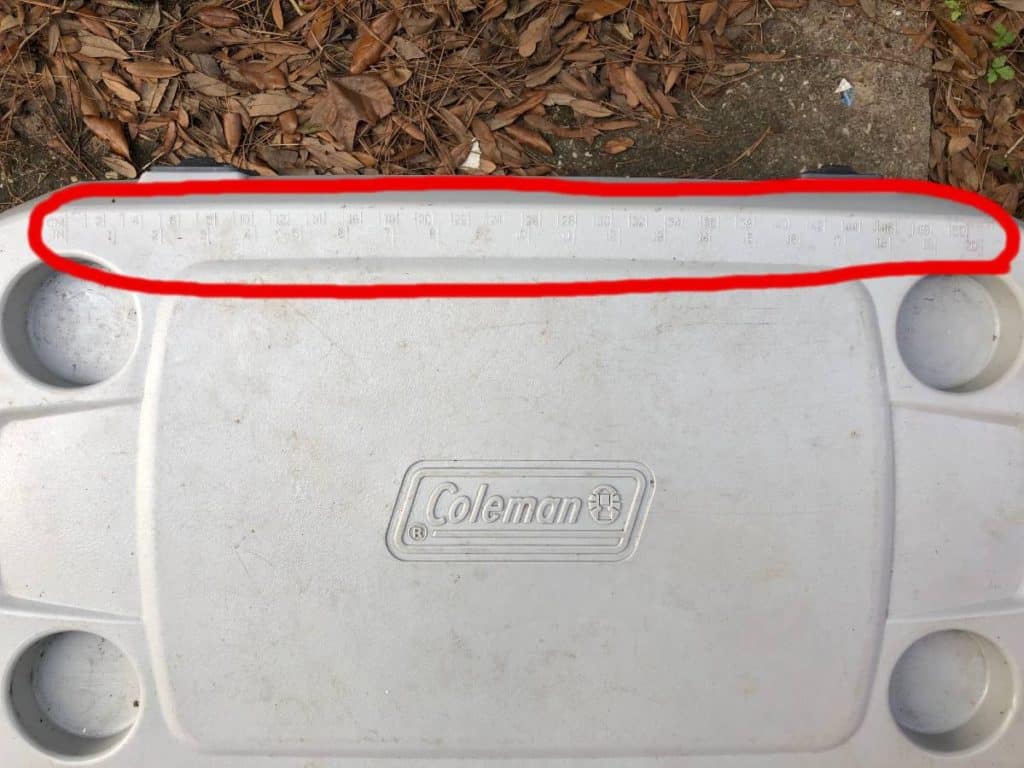
Cutting Tool
The third essential component in any tackle box is cutting tool You need a way to cut fishing line. Fingernail clipper style cutters or small scissors are convenient methods to make accurate cuts.
Knives work but aren’t great for clipping off the loose end of fishing knots because you need to cut against a backstop. You should still have a knife in your tackle box to cut up bait, cut rope to length, and for general utility.
Most quality fishing pliers will also have built in line clippers. It’s always good to have redundancy in equipment!
Actual Tackle Box or Tackle Bag Selection
A tackle box or tackle bag keeps your gear separated and organized. Tackle boxes come in all shapes and sizes. Tackle boxes will have space for plastic organizer bags and pouches for other loose gear (like soft plastic baits).
Pick a tackle box based on your personal preferences. For most anglers a grab and go sized tackle box is ideal.
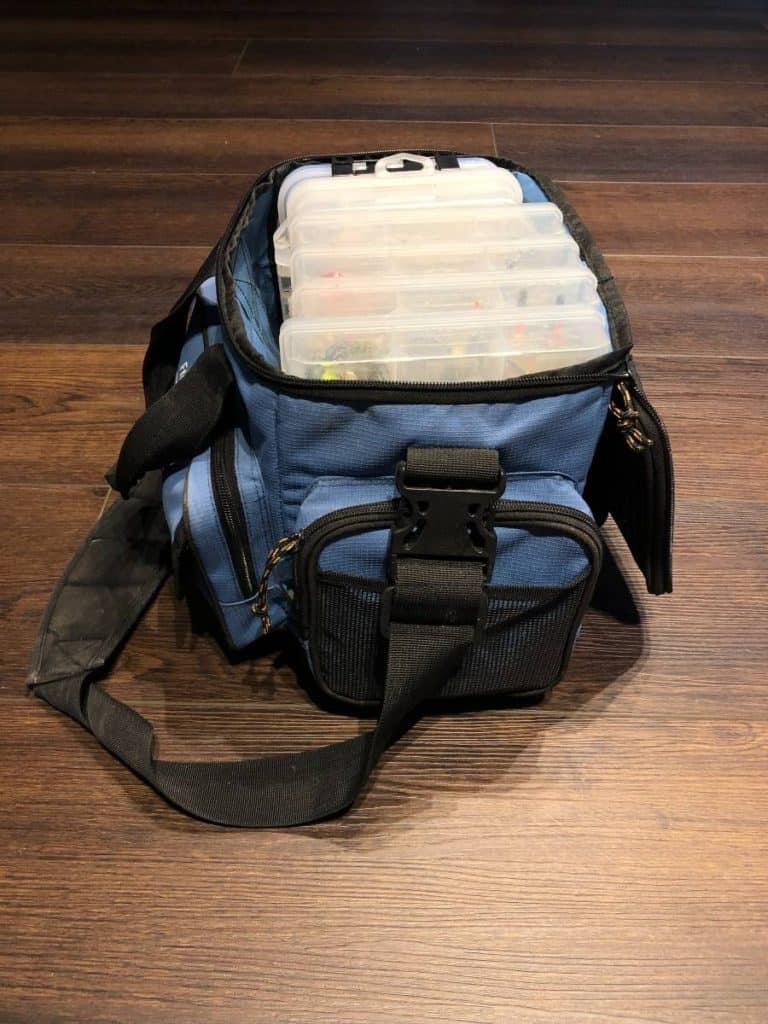
Size down if you need to carry longer distances. Size up if you fish out of a boat (i.e. don’t have to carry the tackle box around!) and have a bunch of equipment. Higher end tackle boxes are made from better materials and have additional (nice to have but not necessary) features.
Again, pick what you like. As long as your gear is organized and you can get it to your fishing location just about any container will work.
Hooks
Every tackle box should have a selection of hooks for use with live bait. There are a whole bunch of hook types. To keep it simple, every tackle box should have assorted sizes of circle hooks, bait hooks, and treble hooks.

Circle hooks are my favorite choice when using bait because circle hooks are better for the fish (hooksets tend to be in the side of the mouth), they will automatically hook the fish if the bait is picked up, and they don’t snag much.
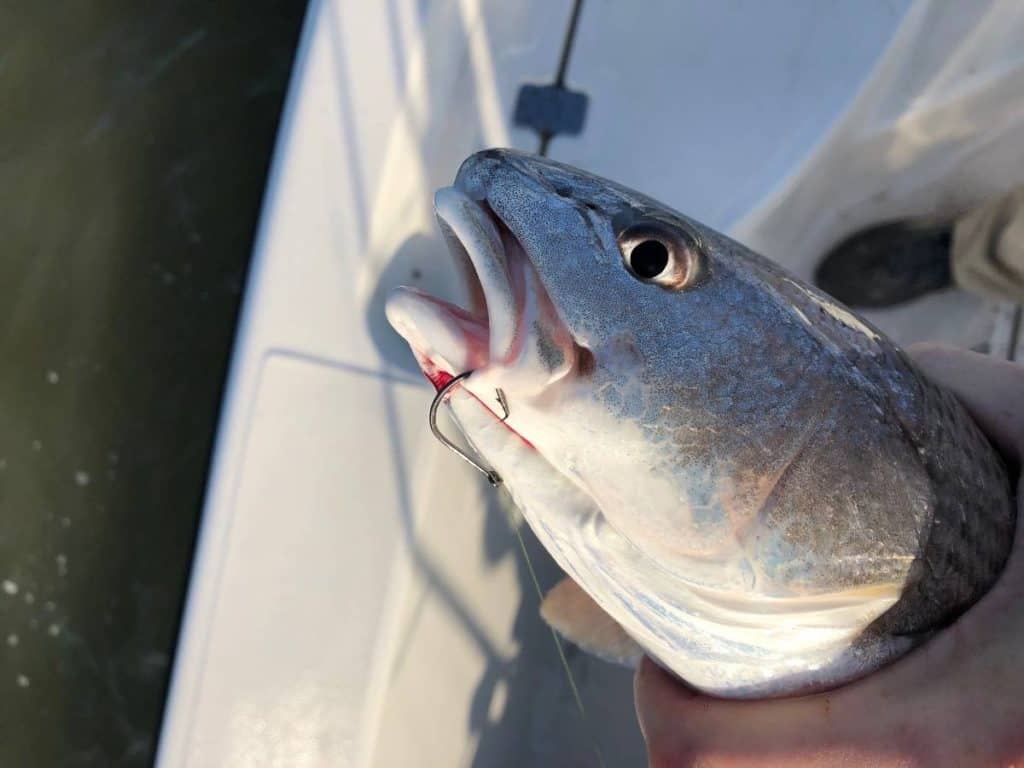
Bait hooks hold bait better (notice the extra bait holder barbs on the hook shank) but fish need to be manually hooked. If not paying attention, you can easily gut hook or completely miss a fish. I generally reserve bait hooks for bobber fishing species like bluegill, walleye, and perch.
Treble Hooks can improve your hook-up/miss ratio. Treble hooks on popping corks will successfully hook fish more often than circle hooks. The downside – treble hooks will cause more stress on any fish you throw back (the three hooks cause more damage to fish mouths and can be tough to remove). Treble hooks on bottom rigs, like Carolina Rigs, snag much more than circle hooks.
Cheap hooks get the job done but they will be made of poorer quality metal and be more prone to breaking or rusting. I personally would rather spend an extra couple bucks on quality hooks than to risk losing the fish of a lifetime.
Fishing Sinkers (Fishing Weights)
Sinkers are critical to help get your bait into the strike zone. Wind, current, and water resistance will all affect how quickly and how effectively your bait gets to where you want it. I recommend you have a variety of fishing sinkers available.
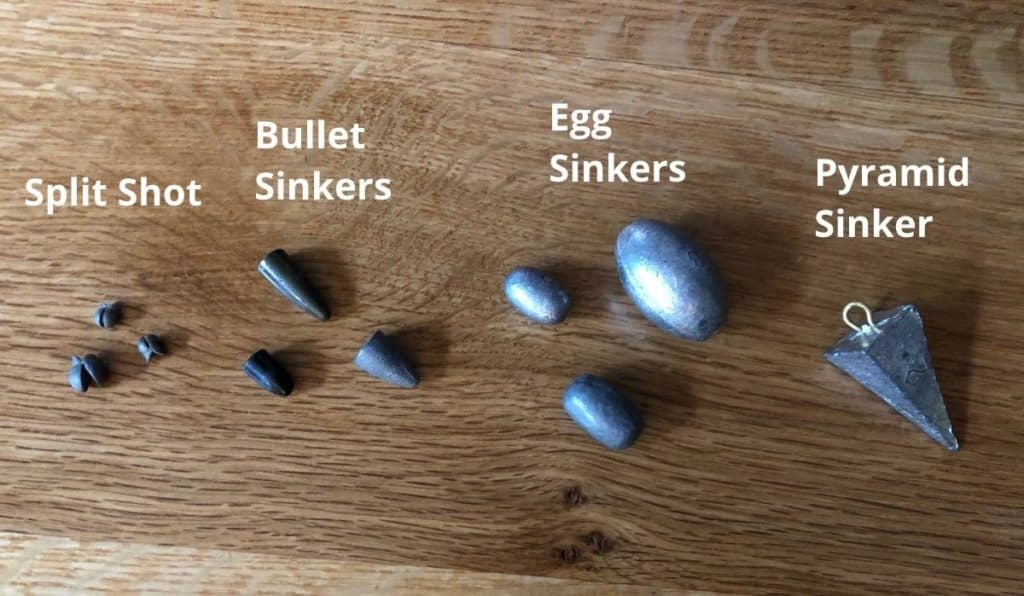
Every tackle box should have assorted:
Egg Sinkers / Barrel Sinkers – In-line weight that can slide up and down your line. Great for bottom fishing rigs targeting redfish, speckled trout, flounder, and catfish.
Pyramid Sinkers / Spider Sinkers / Sputnik Sinkers – Good for heavy duty beach or surf fishing rigs. These are relatively interchangeable. The odd sinker shapes are to help the sinker stay in place in high wind/current or heavy wave action.
Bullet Sinkers – In-line weights great for lighter weighted knocker rigs or bass fishing with artificial worms. Tapered on one end to help slip past snags.
Split Shot – Smaller weights that are ‘clamped’ onto fishing line. Perfect for weighting a slip bobber.
Tungsten Sinkers vs. Lead Sinkers
Sinkers usually come in two materials – tungsten or lead. Lead is cheaper and less dense. Tungsten is more expensive, and more dense (a smaller tungsten weight will weigh the same as a larger lead weight). Either option gets the job done.
Lead Sinkers:
- Pros:
- Cheap
- Gets the job done
- Cons:
- Less dense than tungsten (requires a larger sinker for the same weight)
- Larger size can affect performance in high-current or finesse situations
- Poor for the environment
- Cheap manufacturing can cause sharp edges (can be fixed with a small file). You don’t want your weight to accidentally cut your fishing line
Tungsten Sinkers:
- Pros:
- Denser than lead (smaller sinker for the same weight)
- Smaller size can be beneficial for bait presentation, finesse fishing, and underwater performance
- Usually manufactured to a higher standard (less likely to have sharp edges out of the box)
- Cons:
- More expensive
Fillet Knife
All anglers need a fillet knife. Read our detailed guide for fishing fillet knives!
Having filleted hundreds of fish (mostly freshwater and inshore species), my recommendation for your average angler is an electric fillet knife. If you want to get fancy, grab a battery powered electric fillet knife for the extra convenience.
Keeping regular fillet knives sharp can be a pain in the butt. I find electric fillet knives to be a must. Usually you’re coming home from a long day out in the sun and the last thing you want to mess with is a dull fillet knife. Don’t get me wrong – a properly handled regular fillet knife will result in better fillets but I still bet 95% of anglers will appreciate the convenience of an electric knife.
Fishing Net
Bring a net. There is nothing more frustrating than losing your catch just before you lay hands on it. Once a fish is hooked, the most likely place for it to come off is by the boat, especially if you don’t use a net. Flipping fish in the boat is great but you’ll lose less fish if you use a net.
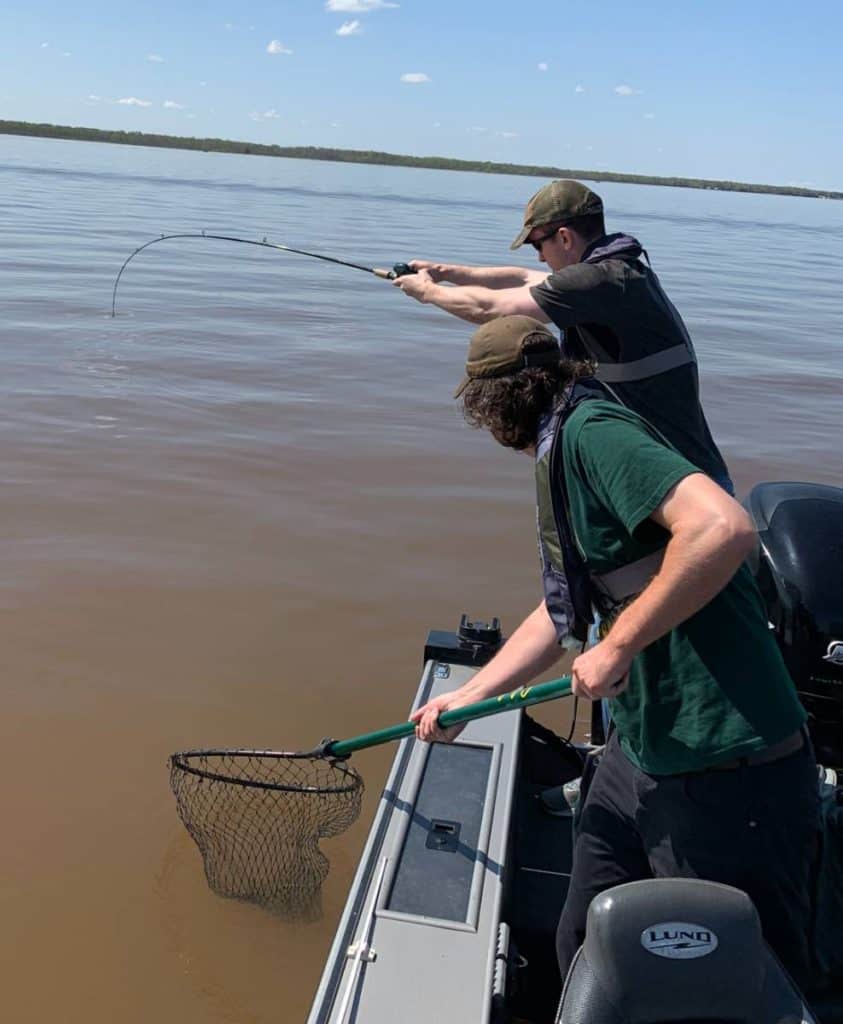
Get a net with rubbery webbing that won’t catch hooks. Nets made with a standard type of rope webbing will embed your hooks and be a pain in the butt to remove.
Fish Species Specific Tackle
While the above items should be in every tackle box, if targeting certain fish species you probably want additional tackle. Listed below are recommended items for targeting popular fish species.
Black Bass Fishing (Largemouth and Smallmouth) Starter Tackle
Black bass (Largemouth bass and Smallmouth bass) are, without a question, the most targeted freshwater fish in the United States. The United State’s National Survey of Fishing, Hunting, and Wildlife-Associated Recreation in 2016 estimated 9,600,000 anglers targeted black bass over a whopping 117,000,000 fishing days.
It would be an injustice not to share recommended lures and baits for a tackle box that accommodates bass fishing.
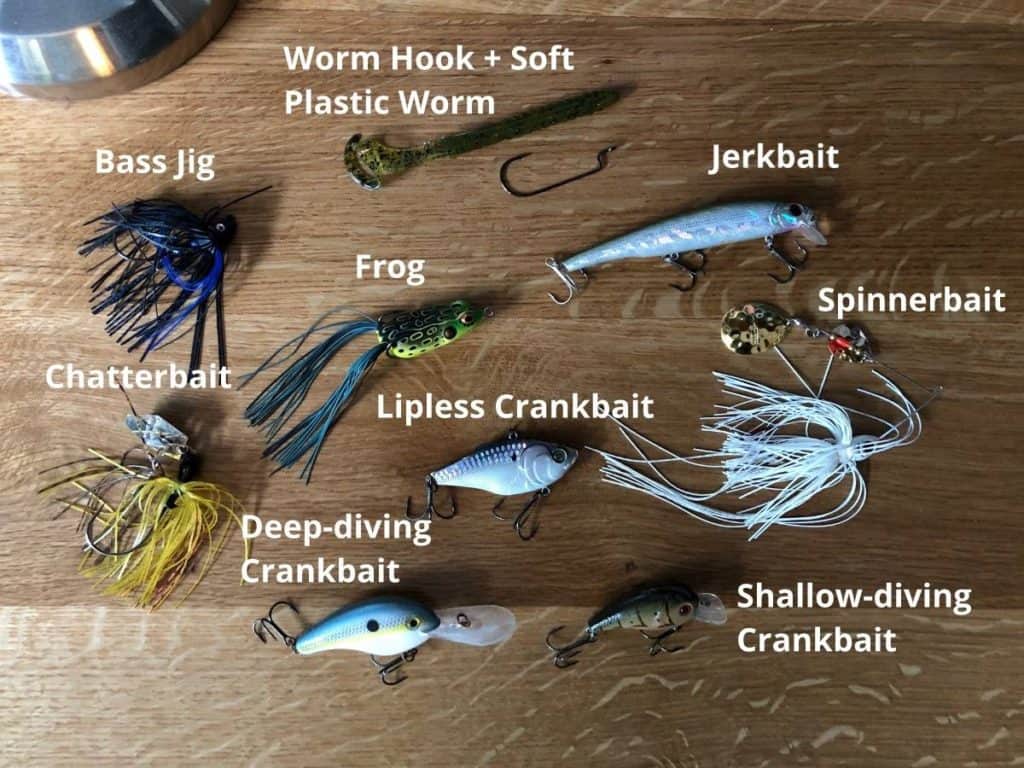
A bass fishing starter kit should have at least one each of:
- Worm Hooks & Soft Plastics
- Bass Jig (with optional soft plastic ‘trailer’) – Finesse fish your favorite structure
- Frog – Great for working thick cover (frog floats on the surface)
- Jerkbait – Use a twitch/jerk retrieve to drive bass wild
- Chatterbait (with optional soft plastic ‘trailer’) – similar to a bass jig but with more wiggle action
- Lipless Crankbait – Great for covering water. Can be fished at multiple depths
- Spinnerbait – Looks weird, catches bass. Usually fished shallow but can slow down to fish deeper
- Deep-diving Crankbait – For targeting deeper structure
- Shallow-diving Crankbait – For targeting shallow/medium depth structure
Beginner Tip: Crankbaits and Spinnerbaits are the most beginner friendly bass baits. Cast them out and retrieve at a consistent pace and you will catch fish. The other options on this list are effective, but may require a more experienced touch to fish effectively.
Don’t overthink it on bait colors. My rule of thumb is to have a light and a dark color option for each bait type. White/silver and darker natural looking color (usually green or brown).
Pro Tip: Match the hatch. If you know the size/color of the prey species on your body of water, try to match your bait to that size/color. If unknown, try light/dark variations of different bait types until you start catching fish.
Panfish Starter Tackle
While bass may fight like crazy, everybody likes catching a mess of panfish. Young anglers are usually started on panfish because of the (potentially) fast action.
Panfish are primarily targeted using fresh, live bait.

For a panfish oriented tackle box, add:
- Slip Bobber Components
- Small bait hooks (panfish generally have small mouths – size No 6 to 10 hooks work well)
- Split shot to bring your bait to the strike zone
- Slip bobber
- Optional Bead can stop the stopper knot getting caught in the top of the bobber
- Stopper Knot
- Knot style stoppers work well for monofilament fishing line but can slip too much on braid
- Rubber style holds better on braided line
- Jig Heads for bottom fishing – rig up a worm, leech, or minnow and fish near structure
Inshore Fishing Starter Tackle (Redfish, Speckled Trout, Flounder)
Fortunately, the big inshore three (redfish, speckled trout, and flounder) hit on generally similar baits.
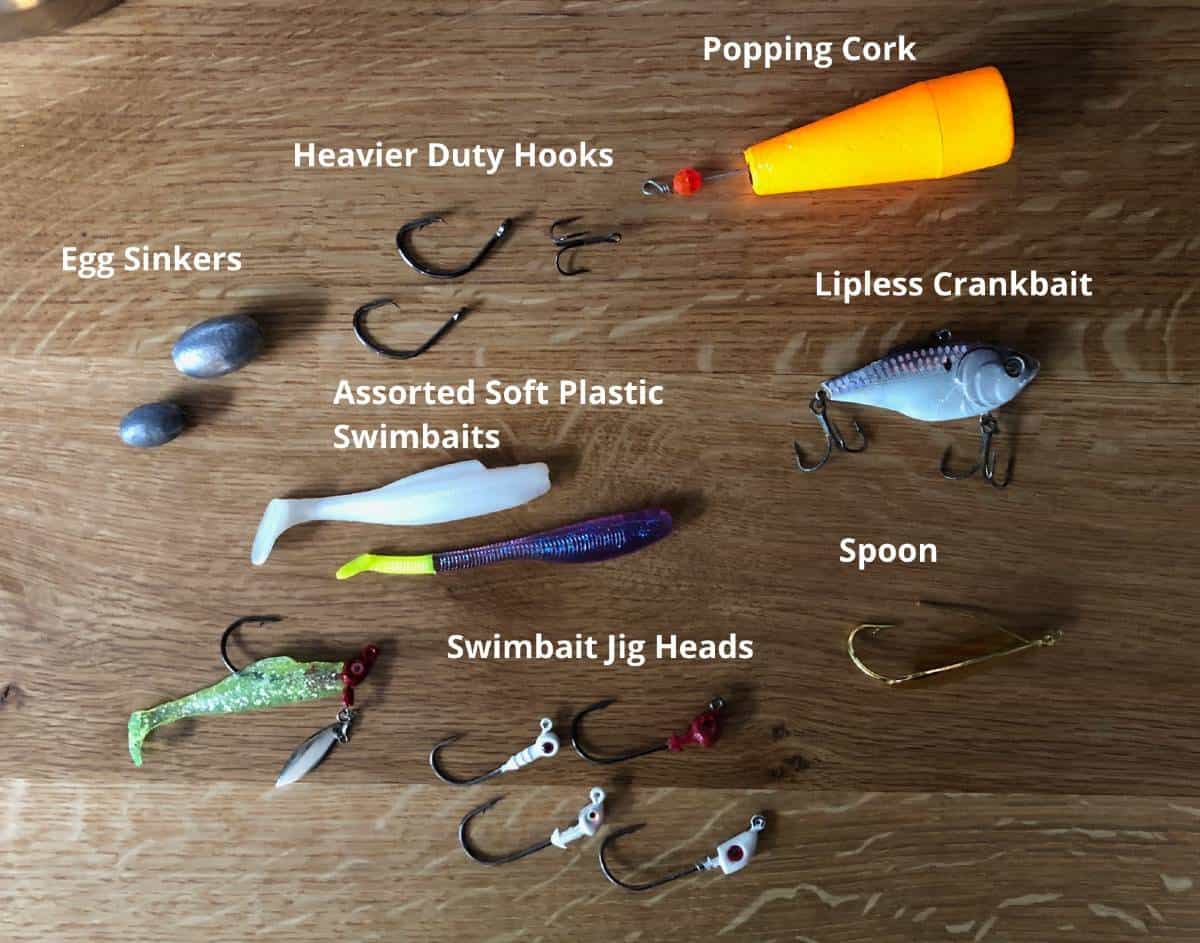
For a starter inshore tackle box get:
- Tackle for live bait
- Popping Cork
- Heavier duty hooks
- Heavier sinkers for use in current and waves
- Equipment to fish soft plastics on jig heads
- Assorted Soft Plastic Swimbaits
- I primarily use paddletail & curly tail soft plastics
- Swimbait Jig Heads in assorted sizes and colors
- Assorted Soft Plastic Swimbaits
- Spoon – An old classic
- Lipless Crankbait – Easy to fish and effective
Same comment on bait color as for bass – have dark and light color options available. Don’t overthink it. Nine times out of ten I start fishing with a white soft plastic.
Pro Tip: Everything in the ocean eats live shrimp. If you just want to catch fish, use live shrimp for inshore fishing.
Conclusion
Fishing is a gear-heavy hobby. Obtain a few key tackle box essentials and you’ll be catching limits of fish in no time.
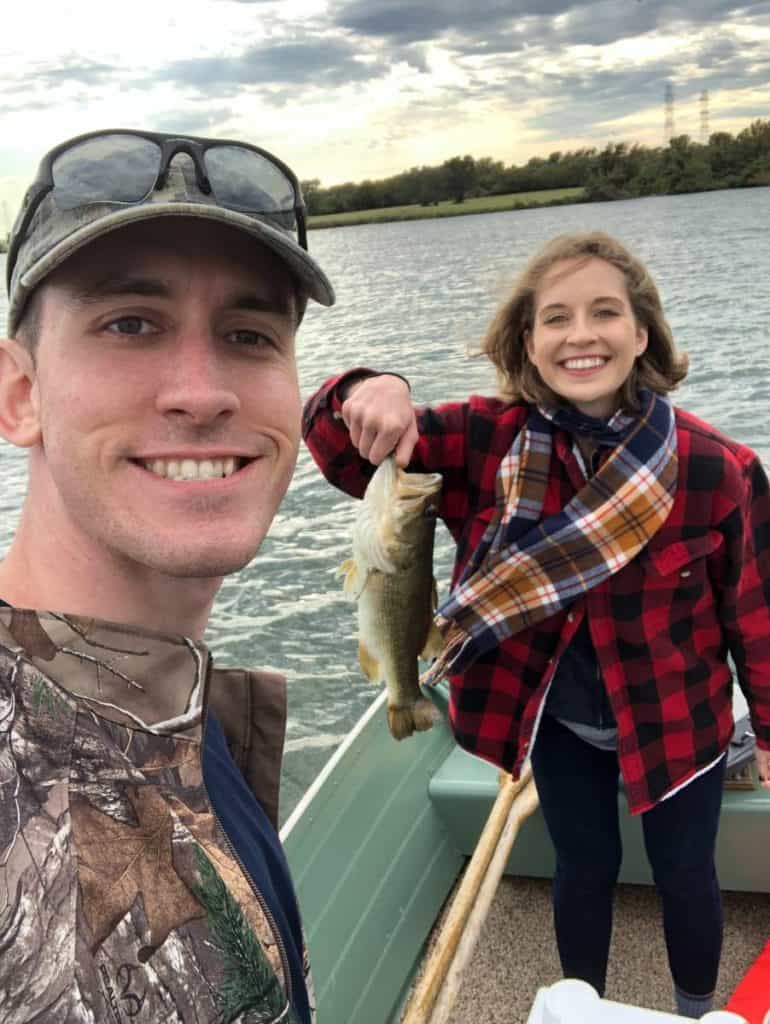
Live bait is almost always effective but artificial baits still have their place in any angler’s tackle box. Check out our strategies for Slip Bobbers and Carolina Rigs to round out your fishing toolkit!
Check out our fishing rod articles for solid rod options to help catch more fish:
- Best Bass Fishing Rods
- Best Flipping & Pitching Rods
- Best Frog Fishing Rods
- Best Walleye Rods
- Best Inshore Fishing Rods
- Best Saltwater Fishing Rods
- Best Surf Fishing Rods
- Best Pier Fishing Rods
Check out our articles for great reels to pair with these rods:
- Best Baitcasting Reels
- Best Surf Fishing Reels
- Best Saltwater Baitcasting Reels
- Best Saltwater Spinning Reels
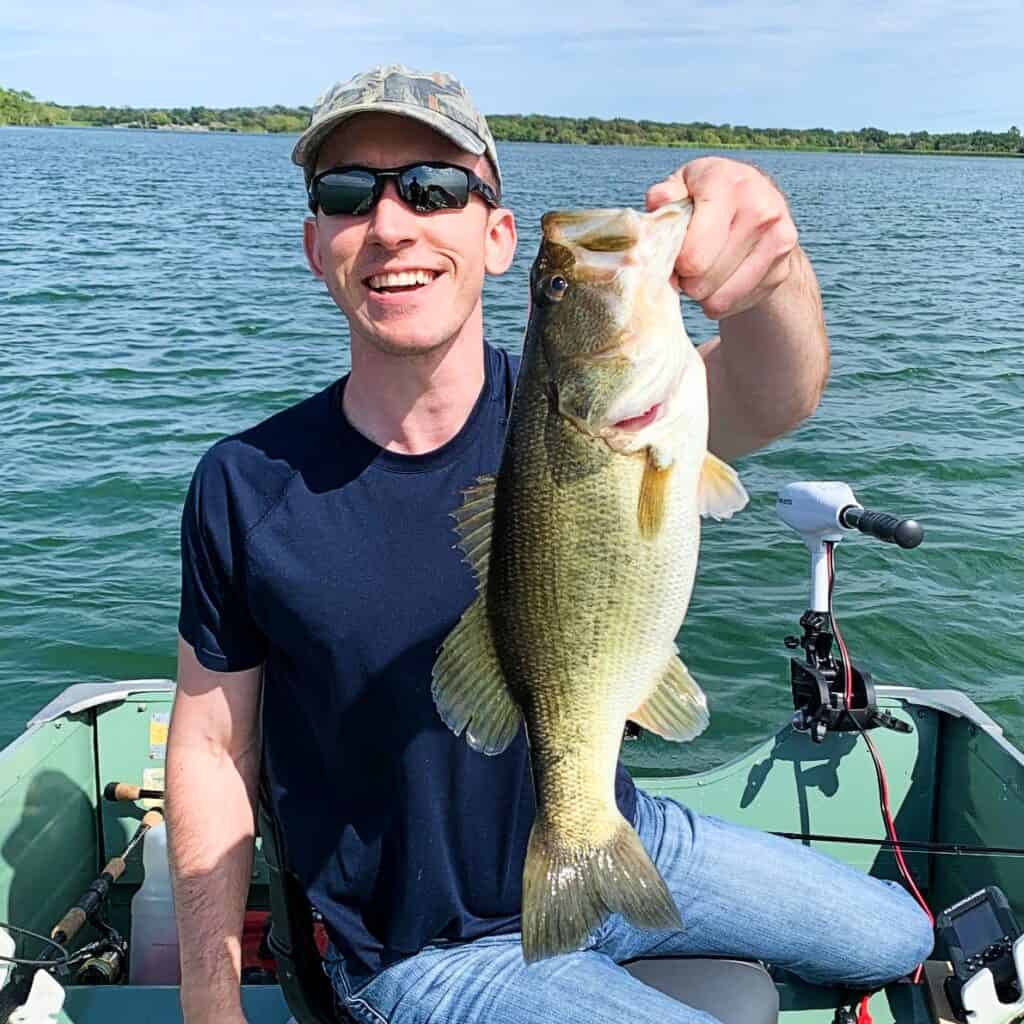
Written By: Andrew Juran
Andrew is a seasoned angler with over 25 years of experience fishing across the United States. He has caught hundreds of fish using various techniques and mentored many in the art of fishing. An advocate for sustainable fishing, Andrew is an active member of the Coastal Conservation Association, an organization committed to marine conservation.
For frequent fishing tips, behind-the-scenes looks, and real-time catches, connect with Andrew on Instagram
